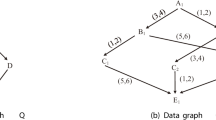Abstract
Temporal Constraint Satisfaction Problems (TCSP) is a well-known approach for representing and processing temporal knowledge. Important properties of the knowledge can be inferred by computing the minimal networks of TCSPs. Consistency and feasible values are immediately obtained; computing solutions can be assisted. Yet, in general, computing the minimal network of a disjunctive TCSP is intractable. The minimal network approach requires computation of the full network in order to answer a query. In this paper we characterize TCSPs for which subsets of the minimal network can be computed without having to compute the whole network. The partial computation is enabled by decomposition of the problem into a tree of sub-problems that share at most pairs of time points. Such decompositions are termed sim/2-tree decompositions. For TCSPs that have sim/2-tree decompositions, minimal constraints of input propositions can be computed by independent computations of the minimal networks of the sub-problems at most twice. It is also shown that the sim/2-tree characterization is a minimal set of conditions. The sim/2-tree decomposition extends former results about decomposition of a TCSP into bi-connected components. An algorithm for identifying a sim/2-tree decomposition of a TCSP is provided as well. Finally, the sim/2-tree decomposition is generalized in an inductive manner, which enables components of a decomposition to be further decomposed. For that purpose a model of Structured Temporal Constraint Satisfaction Problems (STCSP(n), 0 ⩽ n), where STCSP(0) is simply TCSP, STCSP(1) is a set of STCSP(0)s, and in general, STCSP(n) for 1 ⩽ n is a set of STCSP(n − 1)s, is introduced.
Similar content being viewed by others
References
A.V. Aho, J.E. Hopcroft and J.D. Ullman, The Design of Computer Algorithms (Addison-Wesley, Reading, MA, 1975) pp. 200-201.
J.F. Allen, Maintaining knowledge about temporal intervals, Commun. ACM 26(11) (1983) 832-843.
J.F. Allen, Towards a general theory of action and time, Commun. Artif. Intell. 23(2) (1984) 123-154.
J.F. Allen and P.J. Hayes, A commonsense theory of time, in: Proc. IJCAI '85 (1985) pp. 528-531.
G. Ariav, A temporally oriented data model, ACM Trans. Database Systems 11(4) (1986).
F. Bacchus, J. Tenenberg and J.A. Koomen, A non-refied temporal logic, Artif. Intell. 52 (1991) 87-108.
M. Balaban and Y. Kornatzky, A data model for processes based on relative time, J. Intell. Inform. Systems 7(1) (1996) 29-50.
M. Boddy, J. Carciofini and B. Schrag, Managing disjunction for practical temporal reasoning, in: Proc. KR-92 (1992).
J. Clifford and D.S. Warren, Formal semantics for time in databases, ACM Trans. Database Systems 8(2) (1983).
T. Dean, Using temporal hierarchies to efficiently maintain large temporal data base, J. ACM 36(4) (1989) 687-718.
T.M. Dean and D.V. McDermott, Temporal data base management, Artif. Intell. 32 (1987) 1-55.
R. Dechter, I. Meiri and J. Pearl, Temporal constraint network, Artif. Intell. 49 (1991) 61-95.
R. Dechter and J. Pearl, Network based heuristics for constraint satisfaction problems, Artif. Intell. 34(1) (1988) 1-38.
R. Dechter and J. Pearl, Tree clustering for constraint networks, Artif. Intell. 38 (1988) 353-366.
E.C. Freuder, A sufficient condition of backtrack-bounded search, J. ACM 32 (1985) 755-761.
M.C. Golumbic and R. Shamir, Complexity and algorithms for reasoning about time: A graph-theoretic approach, J. ACM 40 (1993) 1108-1133.
M. Gyssens, P.G. Jeavons and D.A Choen, Decomposition constraint satisfaction problems using data base techniques, Artif. Intell. 66 (1994) 57-89.
C.S. Jensen, L. Mark and N. Roussopoulos, Incremental implementation model for relational databases with transaction time, IEEE Trans. on Knowledge and Data Engineering (1990).
P. Jonsson and C. Backstrom, A linear-programming approach to temporal reasoning, in: Proc. AAAI-96 (1996) pp. 1235-1240.
H. Kautz and P.B. Ladkin, Integrating metric and qualitative temporal reasoning, in: Proc. AAAI-91 (1991) pp. 241-246.
P.B. Ladkin and A. Reinefeld, Effective solution of qualitative interval constraint problem, Artif. Intell. 57 (1992) 105-124.
D. McDermott, A temporal logic for reasoning about processes and plans, Cognitive Science 6 (1982) 101-155.
I. Meiri, Combining qualitative and quantitative constraints in temporal reasoning, Artif. Intell. 87(1–2) (1996) 343-385.
J. Moyne, T. Teorey and L. McAfee, Time sequence ordering extensions to the entity-relationship model and their application to automated manufacturing process, Data & Knowledge Engineering 6 (1991) 421-443.
M. Poesio and R.J. Brachman, Metric constraints for maintaining appointments: Dates and repeated activities, in: Proc. AAAI-91 (1991) 253-259.
T. Rosen, Structured temporal constraints satisfaction problems, M.Sc. dissertation, Ben-Gurion University of the Negev, Beer Sheva, Israel (1995).
E. Schwalb and R. Dechter, Processing disjunctions in temporal constraint networks, Artif. Intell. 93(1–2) (1997) 29-41.
Y. Shoham, Reasoning about change: time and causation from the stand point of artificial intelligent, Ph.D. dissertation, Yale University (1986).
P. Van Beek, Reasoning about qualitative temporal information, Artif. Intell. 58 (1992) 297-326.
G.T.J. Wuu and U. Dayal, A uniform model for temporal object-oriented databases, Proc. IEEE Data Engineering (1992) 584-593.
Author information
Authors and Affiliations
Rights and permissions
About this article
Cite this article
Balaban, M., Rosen, T. STCSP — structured temporal constraint satisfaction problems. Annals of Mathematics and Artificial Intelligence 25, 35–67 (1999). https://doi.org/10.1023/A:1018913618840
Issue Date:
DOI: https://doi.org/10.1023/A:1018913618840



